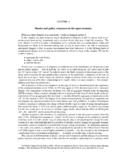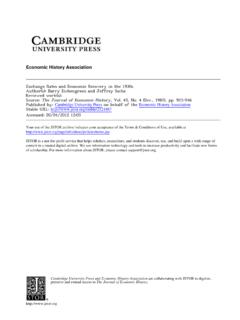Transcription of This PDF is a selection from an out-of-print volume …
1 This PDF is a selection from an out-of-print volume from the National Bureau of Economic Research volume Title: Financial Markets and Financial Crises volume Author/Editor: R. Glenn Hubbard, editor volume Publisher: University of Chicago Press volume ISBN: 0-226-35588-8. volume URL: Conference Date: March 22-24,1990. Publication Date: January 1991. Chapter Title: The Gold Standard, Deflation, and Financial Crisis in the Great Depression: An International Comparison Chapter Author: Ben Bemanke, Harold James Chapter URL: Chapter pages in book: (p. 33 - 68). The Gold Standard, Deflation, and Financial Crisis in the Great Depression: An International Comparison Ben Bernanke and Harold James Introduction Recent research on the causes of the Great Depression has laid much of the blame for that catastrophe on the doorstep of the international gold standard. In his new book, Temin (1989) argues that structural flaws of the interwar gold standard, in conjunction with policy responses dictated by the gold standard's "rules of the game," made an international monetary contraction and deflation almost inevitable.
2 Eichengreen and Sachs (1985) have presented evidence that countries which abandoned the gold standard and the associated contraction- ary monetary policies recovered from the Depression more quickly than coun- tries that remained on gold. Research by Hamilton (1987, 1988) supports the propositions that contractionary monetary policies in France and the United States initiated the Great Slide, and that the defense of gold standard parities added to the deflationary The gold standard-based explanation of the Depression (which we will elaborate in section ) is in most respects compelling. The length and depth of the deflation during the late 1920s and early 1930s strongly suggest a mon- etary origin, and the close correspondence (across both space and time) be- tween deflation and nations' adherence to the gold standard shows the power of that system to transmit contractionary monetary shocks. There is also a high correlation in the data between deflation (falling prices) and depression (falling output), as the previous authors have noted and as we will demonstrate again below.
3 Ben Bemanke is professor of economics and public affairs at Princeton University and a re- search associate of the National Bureau of Economic Research. Harold James is assistant profes- sor of history at Princeton University. The authors thank David Fernandez, Mark Griffiths, and Holger Wolf for invaluable research assistance. Support was provided by the National Bureau of Economic Research and the National Science Foundation. 33. 34 Ben Bernanke and Harold James If the argument as it has been made so far has a weak link, however, it is probably the explanation of how the deflation induced by the malfunctioning gold standard caused depression; that is, what was the source of this massive monetary non-neutrality?2 The goal of our paper is to try to understand better the mechanisms by which deflation may have induced depression in the 1930s. We consider several channels suggested by earlier work, in particular effects operating through real wages and through interest rates.
4 Our focus, however, is on a channel of transmission that has been largely ignored by the recent gold standard literature; namely, the disruptive effect of deflation on the financial system. Deflation (and the constraints on central bank policy imposed by the gold standard) was an important cause of banking panics, which occurred in a number of countries in the early 1930s. As discussed for the case of the United States by Bernanke (1983), to the extent that bank panics interfere with nor- mal flows of credit, they may affect the performance of the real economy;. indeed, it is possible that economic performance may be affected even without major panics, if the banking system is sufficiently weakened. Because severe banking panics are the form of financial crisis most easily identified empiri- cally, we will focus on their effects in this paper. However, we do not want to lose sight of a second potential effect of falling prices on the financial sector, which is "debt deflation" (Fisher 1933; Bernanke 1983; Bernanke and Gertler 1990).
5 By increasing the real value of nominal debts and promoting insol- vency of borrowers, deflation creates an environment of financial distress in which the incentives of borrowers are distorted and in which it is difficult to extend new credit. Again, this provides a means by which falling prices can have real effects. To examine these links between deflation and depression, we take a com- parative approach (as did Eichengreen and Sachs). Using an annual data set covering twenty-four countries, we try to measure (for example) the differ- ences between countries on and off the gold standard, or between countries experiencing banking panics and those that did not. A weakness of our ap- proach is that, lacking objective indicators of the seriousness of financial problems, we are forced to rely on dummy variables to indicate periods of crisis. Despite this problem, we generally do find an important role for finan- cial crises particularly banking panics in explaining the link between fall- ing prices and falling output.
6 Countries in which, for institutional or historical reasons, deflation led to panics or other severe banking problems had signifi- cantly worse depressions than countries in which banking was more stable. In addition, there may have been a feedback loop through which banking panics, particularly those in the United States, intensified the severity of the world- wide deflation. Because of data problems, we do not provide direct evidence of the debt-deflation mechanism; however, we do find that much of the appar- ent impact of deflation on output is unaccounted for by the mechanisms we 35 Financial Crisis in the Great Depression explicitly consider, leaving open the possibility that debt deflation was impor- tant. The rest of the paper is organized as follows. Section briefly recapitu- lates the basic case against the interwar gold standard, showing it to have been a source of deflation and depression, and provides some new evidence con- sistent with this view.
7 Section takes a preliminary look at some mecha- nisms by which deflation may have been transmitted to depression. In section , we provide an overview of the financial crises that occurred during the interwar period. Section presents and discusses our main empirical results on the effects of financial crisis in the 1930s, and section concludes. The Gold Standard and Deflation In this section we discuss, and provide some new evidence for, the claim that a mismanaged interwar gold standard was responsible for the worldwide deflation of the late 1920s and early 1930s. The gold standard generally viewed at the time as an essential source of the relative prosperity of the late nineteenth and early twentieth centuries . was suspended at the outbreak of World War I. Wartime suspension of the gold standard was not in itself unusual; indeed, Bordo and Kydland (1990) have argued that wartime suspension, followed by a return to gold at prewar pari- ties as soon as possible, should be considered part of the gold standard's nor- mal operation.
8 Bordo and Kydland pointed out that a reputation for returning to gold at the prewar parity, and thus at something close to the prewar price level, would have made it easier for a government to sell nominal bonds and would have increased attainable seignorage. A credible commitment to the gold standard thus would have had the effect of allowing war spending to be financed at a lower total cost. Possibly for these reputational reasons, and certainly because of wide- spread unhappiness with the chaotic monetary and financial conditions that followed the war (there were hyperinflations in central Europe and more mod- erate but still serious inflations elsewhere), the desire to return to gold in the early 1920s was strong. Of much concern however was the perception that there was not enough gold available to satisfy world money demands without deflation. The 1922 Economic and Monetary Conference at Genoa addressed this issue by recommending the adoption of a gold exchange standard, in which convertible foreign exchange reserves (principally dollars and pounds).
9 As well as gold would be used to back national money supplies, thus "econo- mizing" on gold. Although "key currencies" had been used as reserves before the war, the Genoa recommendations led to a more widespread and officially sanctioned use of this practice (Lindert 1969; Eichengreen 1987). During the 1920s the vast majority of the major countries succeeded in re- turning to gold. (The first column of table gives the dates of return for the 36 Ben Bernanke and Harold James countries in our data set.) Britain returned at the prewar parity in 1925, despite Keynes's argument that at the old parity the pound would be overvalued. By the end of 1925, out of a list of 48 currencies given by the League of Nations (1926), 28 had been pegged to gold. France returned to gold gradually, fol- lowing the Poincare stabilization, although at a new parity widely believed to undervalue the franc. By the end of 1928, except for China and a few small countries on the silver standard, only Spain, Portugal, Rumania, and Japan had not been brought back into the gold standard system.
10 Rumania went back on gold in 1929, Portugal did so in practice also in 1929 (although not offi- cially until 1931), and Japan in December 1930. In the same month the Bank for International Settlements gave Spain a stabilization loan, but the operation was frustrated by a revolution in April 1931, carried out by republicans who, as one of the most attractive features of their program, opposed the foreign stabilization credits. Spain thus did not join the otherwise nearly universal membership of the gold standard club. The classical gold standard of the prewar period functioned reasonably smoothly and without a major convertibility crisis for more than thirty years. In contrast, the interwar gold standard, established between 1925 and 1928, had substantially broken down by 1931 and disappeared by 1936. An exten- sive literature has analyzed the differences between the classical and interwar gold standards. This literature has focused, with varying degrees of emphasis, both on fundamental economic problems that complicated trade and monetary adjustment in the interwar period and on technical problems of the interwar gold standard itself.















